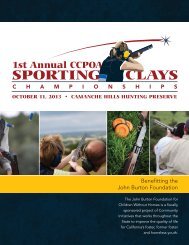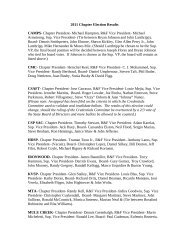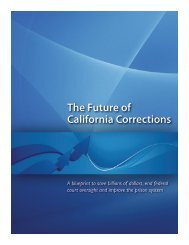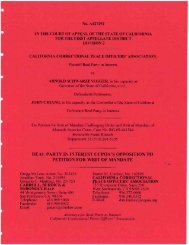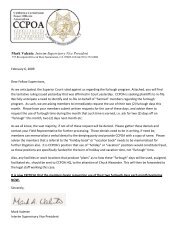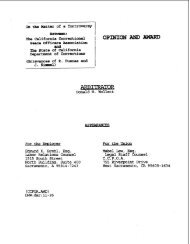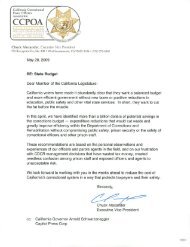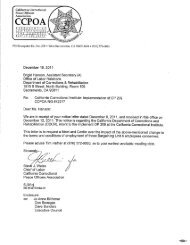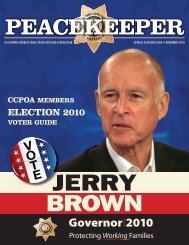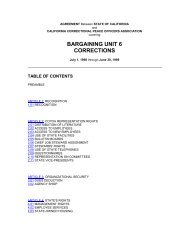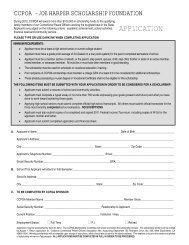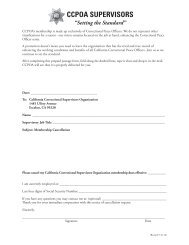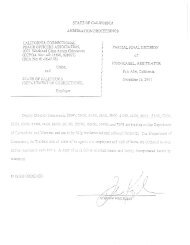california department of arbitration corrections - san quentin opinion ...
california department of arbitration corrections - san quentin opinion ...
california department of arbitration corrections - san quentin opinion ...
Create successful ePaper yourself
Turn your PDF publications into a flip-book with our unique Google optimized e-Paper software.
CALIFORNIA DEPARTMENT OF I ARBITRATION<br />
CORRECTIONS - SAN QUENTIN<br />
I<br />
and<br />
I<br />
I<br />
I OPINION<br />
I<br />
I A !<br />
CALIFORNIA CORRECTIONAL I<br />
I AWARD<br />
PEACE OFFICERS ASSOCIATION<br />
Grievances <strong>of</strong> Doug Hines<br />
I<br />
I<br />
I<br />
I<br />
Before:<br />
Anita Christine Knowlton<br />
Arbitrator<br />
Appearances: For the Authority Joan Branin<br />
Department <strong>of</strong> Personnel Administration<br />
For the Association Shawn P. Cloughesy<br />
Supervising Legal Counsel<br />
Cali fomia Correctional Peace<br />
Officers Association<br />
DPA NOS. 89-06-01 88; 89-06-0215; 89-06-0249; 90-06-007<br />
CCPOA Nos. CDC G6-89, 910234 and 91-259; SQ 90-89 and 90-056; SQ 90-025 and 90-018;<br />
CDC G6-89 and 91-299; Immediate Arbitration Request <strong>of</strong> March 7, 1990<br />
This <strong>arbitration</strong> arises under a memorandum <strong>of</strong> understanding between the parties,<br />
effective May 26, 1989 through June 30, 199 1. The arbitrator was designated on June 18, 1991<br />
in accordance with Article VI <strong>of</strong> the MOU. The parties stipulated that this dispute was properly<br />
before the arbitrator.<br />
A hearing was held on August 30, December 11; 12, 13, 1991, and March 12, 13, 25,<br />
May 26, 1992 in San Quentin, California at which time each party had an opportunity to<br />
introduce evidence and examine and cross-examine witnesses.<br />
The grievant was present<br />
throughout the hearing. Both parties submitted written closing briefs and reply arguments.
CALIFORNIA AND CCPOA<br />
Grievances <strong>of</strong> Do* Hines<br />
ISSUES<br />
The parties agreed that the arbitrator would frame the issues. They are:<br />
'Did the Department violate §5.03(a) <strong>of</strong> the Agreement by imposing the<br />
February.9, 1990 two-step pay reduction for one year<br />
Did the Department violate $5.03(a) <strong>of</strong> the Agreement by issuing the<br />
November 1, 1989 letter <strong>of</strong> instruction<br />
Did the Department violate 810.02 <strong>of</strong> the Agreement when it<br />
denied the grievant sick leave credit for October 23, 1989<br />
Did the Department violate g9.06(b) <strong>of</strong> the Agreement when it<br />
issued a letter <strong>of</strong> instruction on April 25, 1990, more than thirty<br />
days after the close <strong>of</strong> the investigation<br />
Did the Department violate §5.03(a) <strong>of</strong> the Agreement when it<br />
issued the April 25, 1990 letter <strong>of</strong> instruction<br />
Did the Department violate 5.03(a) <strong>of</strong> the Agreement when it<br />
issued the February 22, 1990 supplemental performance appraisal<br />
Is the grievance about the discussion <strong>of</strong> the diversion <strong>of</strong> H-Unit<br />
<strong>of</strong>ficers mooted by the retirement <strong>of</strong> associate warden Tabash<br />
Did the Department violate §5.03(a) <strong>of</strong> the Agreement during the<br />
conversation between the grievant and associate warden Tabash<br />
about the diversion <strong>of</strong> H-Unit <strong>of</strong>ficers<br />
If the Department is found to have violated the contract, what is<br />
the appropriate remedy
CALIFORNIA AND CCPOA<br />
Grievances <strong>of</strong> Doug Hines<br />
FACTUAL SUMMARY<br />
The California Department <strong>of</strong> Corrections operates various adult penal institutions in the<br />
state. Its correctional peace <strong>of</strong>ficers are represented by the Association for collective bargaining<br />
purposes. The grievant, Doug Hines, has been a correctional peace <strong>of</strong>ficer with the Department<br />
at San Quentin State Prison since September 26, 1977. He is assigned to work as a housing<br />
<strong>of</strong>ficer in H-Unit, a Level 2 operation for medium custody inmates.<br />
The grievant has been an Association activist since 1983. He has served as a chapter<br />
board member, the health and safety job steward, the chapter vice president, the chief job<br />
steward <strong>of</strong> H-Unit and chapter president. He has represented members in interviews and<br />
hearings, filed OSHA complaints, organized informational pickets, lobbied state legislators,<br />
contacted the state attorney general and spoken to the press about Association concerns. He has<br />
filed over 400 grievances against management <strong>of</strong>ficials, including grievances against several <strong>of</strong><br />
the managers involved in the claims at issue here.<br />
Hines contends that the Department discriminated against him for his union activities by<br />
issuing four personnel actions and interfering with the performance <strong>of</strong> his steward duties. The<br />
grieved actions are a two-step pay reduction for one year for mishandling asbestos, a letter <strong>of</strong><br />
instruction for misusing sick leave and denial <strong>of</strong> sick leave credit, a letter <strong>of</strong> instruction for<br />
failing to wear a hat and carrying a personal weapon while on duty, a supplemental annual<br />
performance report containing negative comments, and the refusal <strong>of</strong> the associate warden to<br />
respond to inquiries about the reassignment <strong>of</strong> H-Unit <strong>of</strong>ficers.
CALIFORNIA AND CCPOA<br />
Grievances <strong>of</strong> Dorig Hines<br />
Prior to these events Hines had no adverse actions on file and was thought to be an<br />
average to above average employee. In 1985 he received a letter <strong>of</strong> appreciation and a letter <strong>of</strong><br />
commendation.<br />
1 The two-step pay reduction for mishandling asbestos.<br />
In the latter half <strong>of</strong> the 1980s the Grievant filed several complaints with OSHA. These<br />
resulted in citations noting a massive number <strong>of</strong> violations at the institution. In 1989 the<br />
Department began an asbestos abatement program as part <strong>of</strong> the work required by OSHA.<br />
According to many <strong>of</strong> the managers who testified, a memorandum from the warden on<br />
asbestos was posted throughout the institution and distributed with paychecks that spring. The<br />
notice advised employees about the abatement program and warned them not to touch or disturb<br />
any materials suspected <strong>of</strong> containing asbestos. The grievant was on an industrial disability<br />
leave at the time and did not see a notice accompanying his paycheck. He testified that when<br />
he returned to work he also did not see a posted copy <strong>of</strong> the notice. Other <strong>of</strong>ficers and a<br />
sergeant in H-Unit testified that they did not receive the memo in their paychecks and, although<br />
they regularly checked the unit's bulletin board, they did not see the memo posted.<br />
That fall the Education Building was closed for asbestos removal.<br />
It reopened on<br />
October 2, 1989. Teachers were told that the second floor <strong>of</strong> the building was clear and<br />
instructed to clean the dust and debris in their classrooms. When the <strong>of</strong>ficer assigned to the<br />
building, Vija Burton, arrived for work that morning she was told by the Education Program<br />
supervisor that the third or lowest floor was still closed and there would be no school on that<br />
- 4 -
CALIFORNIA AND CCPOA<br />
Grievances <strong>of</strong> DOG Hines<br />
level. Burton asked a member <strong>of</strong> the abatement crew if the building was safe and whether there<br />
was asbestos inside. After she was told there was still asbestos in the building, Burton contacted<br />
the Association's chapter president, Judy Smith.<br />
Smith called the employee relations <strong>of</strong>ficer, Bobby Hernandez, about the situation. A<br />
short while later Smith, Hernandez and the asbestos coordinator, Duane Honey, inspected the<br />
building. Honey informed the group that both floors had been tested and found to be within<br />
allowable limits. However, Honey noticed pipe lagging in the third floor ceiling which he<br />
suspected might contain asbestos. He said that further abatement would be scheduled there later<br />
in the day. It was also decided that the classrooms would be cleaned by an inmate crew instead<br />
<strong>of</strong> <strong>of</strong>ficers and teachers.<br />
That afternoon Burton contacted the grievant to complain about the asbestos and file a<br />
safety grievance. At the time Hines was the chapter's vice president and safety steward. He<br />
was involved in a bitter election campaign challenging Smith for the presidency. Smith testified<br />
that when she learned the grievant had been summoned, she attempted to discourage him from<br />
becoming involved. Hines, on the other hand, said that Smith never called him to discuss the<br />
situation.<br />
When Hines amved at the Education Building and had a chance to look around, he<br />
noticed white dust and construction debris in the second floor classrooms. He became concerned<br />
that these materials contained asbestos and called Hernandez to complain. Hernandez assured<br />
Hines that the problem had been taken care <strong>of</strong> and referred him to Honey. The grievant called<br />
Honey who explained that the situation was under control and refused to join Hines at the
CALIFORNIX A m CCPOA<br />
Grievances <strong>of</strong> Doug Hines<br />
building. Honey testified that he also told Hines that the third floor still had some asbestos<br />
which was scheduled to be abated that evening. The grievant denies that Honey informed him<br />
about the remaining asbestos.<br />
Hines then toured the third floor with Burton and two teachers who needed to get into<br />
the curriculum room on that level. Their access was not blocked by any warning signs or<br />
barricades. While they were on the third floor, Hines found a piece <strong>of</strong> pipe lagging on the floor<br />
which he suspected contained asbestos. Although he had no formal training about asbestos, the<br />
grievant had accompanied Cal/OSHA inspectors on their tours <strong>of</strong> the facility. They pointed out<br />
materials suspected <strong>of</strong> containing asbestos and took samples. Following the sampling procedures<br />
he had observed, the grievant placed the piece <strong>of</strong> pipe lagging in a clear garbage bag and rolled<br />
it shut, creating a sealed air pocket. This method <strong>of</strong> handling asbestos does not comply with<br />
federal regulations and Departmental requirements.<br />
Hines decided to take the pipe lagging to Hernandez to convince him that the building<br />
should be closed. On his way to the Administration Building the grievant saw Honey's superior,<br />
Dave Johns, in his truck and flagged him down. The grievant showed the bag to Johns and<br />
indicated that it contained asbestos from the Education Building. Johns <strong>of</strong>fered to take the bag<br />
from Hines; but the grievant said he wanted to show it to Hernandez.<br />
The grievant proceeded to Hernandez's <strong>of</strong>fice, showed him the bag and requested the<br />
Education Building be closed. Hernandez directed Hines to take the bag to Honey. On the way,<br />
the grievant stopped and showed the bag to Smith and Officer Robert Trono. When Hines<br />
arrived in the Maintenance Department, Honey took the bag, taped its neck shut and placed.it
CALIFORNIA AND CCPOA<br />
Grievances <strong>of</strong> Doug Hines<br />
behind the <strong>of</strong>fice door. A decision was made about an hour later to post the hazard and erect<br />
plastic sheeting and other physical barriers across access points to the third floor hallway where<br />
the pipe lagging was found.<br />
The pipe lagging was subsequently tested and found to contain 30% asbestos. Pursuant<br />
to federal regulations the warden sent notices to the grievant and the employees who had seen<br />
been shown the pipe lagging informing them <strong>of</strong> a possible exposure to asbestos. They were<br />
given physical examinations and told that their health would be monitored for the next thirty<br />
years. This monitoring is a significant expense to the Department.<br />
John M. Charleston was worlung as the outside patrol sergeant during this period. On<br />
one <strong>of</strong> his evening rounds in the Administration Building, he saw Hernandez walking in the hall,<br />
saying to himself, "We've got him. We've got him." Charleston was concerned that there had<br />
been an escape he was not aware <strong>of</strong> and asked, "Who do we have" Hernandez replied,<br />
"Hines. " Charleston said, "If that's the case, I don't need to know anything more" and moved<br />
on. Charleston later reported this exchange to Hines. At the hearing, Hernandez denied making<br />
these remarks.<br />
On February 9, 1990, the Department gave Hines a notice <strong>of</strong> adverse action imposing<br />
a two step pay reduction for one year for inefficiency, inexcusable neglect <strong>of</strong> duty,<br />
insubordination and regulation violations. A State Personnel Board Administrative Law Judge<br />
conducted a three day hearing on the merits <strong>of</strong> the adverse action. The Department did not<br />
present the disputed evidence elicited here that Smith and Hernandez tried to discourage Hines<br />
from going to the Education Building and that Honey told him there was asbestos on the third
CALIFORNIA AND CCPOA<br />
Grievances <strong>of</strong> Doug Hines<br />
floor. None <strong>of</strong> this information was contained in the investigative reports developed prior to the<br />
issuance <strong>of</strong> the adverse action.<br />
The State Personnel Board reversed the discipline in a decision stating:<br />
No cause for adverse action was established by the evidence,. The appellant was acting In his<br />
capacity as a Safety Job Steward for the union responding to legitimate employee concerns 'about<br />
the condition <strong>of</strong> a building with a known asbestos problem. He was repeatedly assured by<br />
management <strong>of</strong>ficials that the building was asbestos free. When he came across the piece <strong>of</strong> pipe<br />
lagging on the floor, he picked it up not really thinking it contained asbestos, and was surprised<br />
and upset when he saw what it was.<br />
At this polnt, the ;ri;+ellant had already disturbed the asbestos, and under the circumstances, he<br />
did the best that he could. He placed the asbestos in a plastic bag, twisted the top to maintain an<br />
air seal, and took the bag to the Employee Relations Officer in an attempt to have the Education<br />
Building shut down. Clearly. ~t would have been better if the appellant had not picked up the<br />
plzce <strong>of</strong> asbestos debris. But once he did so, he had to do something with it, and placing ~t in a<br />
plastic bag seems as reasonable as any other course <strong>of</strong> action. The appellant was not an asbestos<br />
removal expert and cqot be held accountable for failing to comply with all <strong>of</strong> the procedures<br />
necessary for asbestos disposal.<br />
It probably would have been better had the appellant simply left the bag where it was or had taken<br />
it directly to the maintenance <strong>department</strong>. However, both the Employee Relations Officer and the<br />
Asbestos Coordinator had already told the appellant that they were not llrtcnsttd in conducting<br />
another inspection <strong>of</strong> the Education Building. Under the circumstances, the appellant's desire to<br />
demonstrate that there was a need for such an inspection is perhaps understandable.<br />
Respondent's theory that the appellant engineered the entire incident by pulling the pipe lagging<br />
down from the ceiling panel himself was never established by any credible evidence. It seems<br />
highly unlikely that the appellant would have jeopardited hs own health by exposing himself to<br />
asbestos simply to carry out some sinister plot to discredit San Quentin management. After all.<br />
the person who received the most contamination in the incident was the appellant himself.<br />
In light <strong>of</strong> the conclusion that there was insufficient cause for discipline, it is unnecessary to<br />
cons~der the appellant's contention that the adverse action was taken in retaliation for his exercise<br />
<strong>of</strong> protected activities. Although the State Personnel Board may be required to consider such<br />
issues in an appropriate case, it is unnecessary to do so where, as here, the disciplinary action is<br />
revoked on the merits.<br />
Burton was criticized for her part in the matter. Her sergeant placed a Counseling<br />
Record in her file for sixty days stating:<br />
On October 3, 1989, Officer Burton reported to me that she had been exposed to asbestos on<br />
October 2nd in the Education Annex. She stated that asbestos was on the floor in the building.<br />
It was determined, through an investigation, that Officer Burton had obsewed powdered gypsum
CALIFORNIA AM) CCPOA<br />
Grievances <strong>of</strong> Doug Hines<br />
on the floor and believed this to be asbestos substance. She inadvertently passed on this<br />
misinformation to supervisors and union <strong>of</strong>ficials that caused them to react to her concerns. It was<br />
detenninzd that Officer Burton, out <strong>of</strong> her fear and her limited lcnowledge <strong>of</strong> asbestos. passed on<br />
information she believed to be true. Officer Burton, in the future, is to qualify her questions when<br />
seeking infonnatlon and to insure that the information received is coming from a competent<br />
source.<br />
Prior to this incident, in April, 1988, two maintenance employees removed a piece <strong>of</strong><br />
floor tile from the institution because they suspected it contained asbestos. They submitted it<br />
to an independent laboratory without notifying their supervisor. The test indicated that the tile<br />
contained an insignificant amount <strong>of</strong> asbestos. The two employees subsequently received letters<br />
<strong>of</strong> instruction for removing state property without authorization.<br />
2. The letter <strong>of</strong> instruction on abuse <strong>of</strong> sick leave and the denial <strong>of</strong> sick leave.<br />
A few weeks after the asbestos incident, on October 23, 1989, Hines arrived at the<br />
institution about an.hour before the start <strong>of</strong> his shift so that he could distribute a copy <strong>of</strong> a letter<br />
he sent to the Attorney General regarding improper inmate access to personnel records. He<br />
reported for his shift at 7:00 a.m.<br />
About two hours later the grievant's wife called the<br />
institution and left a message with Officer Banks that she wanted Hines to call home because his<br />
dogs had escaped from the yard.<br />
Hines said he received this message while he was on his way to the watch commander's<br />
<strong>of</strong>fice to report that he was experiencing stomach cramps. Hines received permission from the<br />
Sergeant Irene Aviles go home sick. She did not ask him to provide medical verification <strong>of</strong> his<br />
illness. The grievant apprised his program sergeant, Robert Frye, that he was leaving for
CALIFORNIA Am CCPOA<br />
Grievances <strong>of</strong> Doug Hines<br />
remainder <strong>of</strong> the day. Hines passed Banks on his way out <strong>of</strong> the H-Unit sallyport. When the<br />
grievant got home he went to the doctor with his son who was also ill.<br />
Later that day Associate Warden Tabash had a conversation with Banks in which Banks<br />
mentioned that Hines had gone home to take care <strong>of</strong> his dogs. At the hearing, Banks explained<br />
that this was an assumption he had drawn from the fact that Hines left a short time after his wife<br />
called about the dogs escaping. He testified his conclusion was not based on anything Hines<br />
said.<br />
Tabash learned that Hines had reported sick for the time <strong>of</strong>f and ordered Frye to write<br />
a letter <strong>of</strong> instruction. Frye did not want to write the letter because it was his impression that .<br />
Hines was sick when he went home. He added that if the grievant needed to leave to take care<br />
his dogs he could have said so as he had left work a few months earlier to rescue his own dogs.<br />
Frye felt that the matter should have been dealt with in an informal discussion rather than a<br />
letter <strong>of</strong> instruction but wrote the letter at his supervisor's insistence.<br />
The letter was issued on November 1, 1989 and said:<br />
On Monday, 10-23-89 at approximately 0930 hours. you stated to me that you had the flu and had<br />
called the Watch Commander to make a sick call and were leaving for the day.<br />
On Tuesday, 10-24-89, 1 was approached by associate warden H. Tabash informing me that he<br />
had received information from another <strong>of</strong>ficer that your sick call was not as stated that, in fact,<br />
just pnor to your sick call, you received an outside call informing you that your dogs had escaped<br />
your yard and were roaming your neighborhood.<br />
It 1s apparent that you have been less than truthful in the reason for leaving your work position<br />
and that you abused the sick leave privilege in violation <strong>of</strong> Director's Rule 13391.<br />
The grievant's request for sick leave for the day was disallowed because he was "less than<br />
truthful with [his] supervisor when [he] requested to go home due to illness."
CALIFORNIA AND CCPOA<br />
Grievances <strong>of</strong> Doug Hines<br />
3. Letter <strong>of</strong> instruction about wearing hat and carrying gun to ovenime assignment.<br />
About a month after the issuance <strong>of</strong> the letter <strong>of</strong> instruction, on December 12, 1989,<br />
Hernandez asked Hines to drop by his <strong>of</strong>fice at the conclusion <strong>of</strong> his shift to discuss a newspaper<br />
article which quoted remarks critical <strong>of</strong> management made by the grievant. Hines asked another<br />
union <strong>of</strong>ficer, D.D. Taylor, to accompany him to the meeting. As Hines and Taylor were<br />
exiting the Administration Building after the meeting, they saw the personnel director, Lt. E.<br />
Glaster. Glaster told Hines he was out <strong>of</strong> uniform because he was not wearing his hat. The<br />
grievant's hat was in his car and he replied that he was "<strong>of</strong>f duty". Glaster said, "I don't care"<br />
and continued up the steps.<br />
Hines explained that he had been involved in two earlier occasions when the issue <strong>of</strong><br />
where and when an <strong>of</strong>ficer may be out <strong>of</strong> uniform was raised, once arising when he was not<br />
wearing a uniform shirt outside the Count Gate and the other when he represented a fellow<br />
<strong>of</strong>ficer who did not have a tie when he was <strong>of</strong>f-duty. In both instances Hernandez confirmed<br />
that an <strong>of</strong>ficer may be out <strong>of</strong> uniform when he is <strong>of</strong>f duty in the area <strong>of</strong> the Administration<br />
Building. The grievant was working two shifts the day he encountered Glaster. He presumed<br />
he was <strong>of</strong>f duty at the time he was leaving the Administration Building because he had signed<br />
out from H-Unit at the conclusion <strong>of</strong> the second watch and expected to be docked for being late<br />
because <strong>of</strong> the meeting to his overtime shift at Marin General Hospital.<br />
Hines left for his overtime shift while Taylor remained and engaged the lieutenant in a<br />
heated colloquy about uniforms which covered situations like wearing a hat to and from work,<br />
at the 7-1 1, and in bed at night. Taylor took <strong>of</strong>f his own hat and told Glaster "where he could<br />
- 11 -
CALIFORNIA ANP CCPOA<br />
Grievances <strong>of</strong> Doug Hines<br />
put it".<br />
Taylor later received a letter <strong>of</strong> instruction telling him to wear his hat outside. He<br />
testified that he deserved this action and did not believe it was issued in response to his union<br />
activities.<br />
When Hines reported at the hospital, the <strong>of</strong>ficer he relieved refused the overtime he was<br />
entitled to by virtue <strong>of</strong> the grievant's tardiness. Hines claimed the time on his travel voucher<br />
and was paid for two consecutive shifts, from 0700 to 2300 hours.<br />
Glaster wrote the grievant up for failing to wear his hat later that day. He said:<br />
...[Hines] was reminded by th~s wnter that.. .he should be in full uniform. which includes wearing<br />
a hat when outside. Officer Hines stated, "I am <strong>of</strong>f duty and do not have to wear a hat." ... I<br />
responded "yes you do. " Officer Hines continued exiting the Administration Building, obviously<br />
in defiance <strong>of</strong> my instructions. Officer Hines' actions will not be tolerated and are a clear act <strong>of</strong><br />
insubordination.<br />
Lieutenant John Stokes was assigned to investigate the incident. At the January 3, 1990<br />
fact finding meeting Hines objected to Stokes serving as the investigator because he had recentiy<br />
filed a grievance challenging Stokes' qualifications for promotion. Hines had called Stokes at<br />
home to find out about the promotion, but the Stokes refused to discuss it and hung up. The<br />
lieutenant denied the objection to his investigation. Ultimately, Stokes concluded that the<br />
grievant had lied in speaking to Glaster because his pay records indicated he was on duty during<br />
the period between the time he left H-Unit and arrived at the hospital.<br />
On January 16, 1990, after Stokes submitted his fact finding report, the grievant<br />
approached him to explain why he had left through the East Gate for his overtime assignment.<br />
During their discussions Hines revealed that he had stopped at the armory located at that gate<br />
to pick up his personal weapon so that he would not have to return to the institution at the
CALIFORNIA AND CCPOA<br />
Grievances <strong>of</strong> Doug Hines<br />
conclusion <strong>of</strong> his overtime shift. Stokes reported this conversation in a memorandum, which<br />
stated:<br />
... Officer Hines stated he wanted to clarify the record as to why he left the East Gate rather than<br />
the West Gate when he travelled to his overtime position at Marin General Hospital on December<br />
12. 1989. Officer Hines stated that he left the East Gate because he first stopped ''Llke he always<br />
does" in order to first pick up his personal weapon prior to going to Marin General for overtime.. .<br />
... It is further noted for the record that the statement <strong>of</strong>fered voluntarily by Officer Hines is a<br />
further example <strong>of</strong> his blatant violations <strong>of</strong> Department Rules. The California Department <strong>of</strong><br />
Corrections Administrative Manual Chapter 4800, Section 4808 specifically prohibits the carrying<br />
<strong>of</strong> a concealed weapon by on-duty employees except as delineated by deportmental procedures or<br />
as authorized by a deputy or assistant director. The carrying <strong>of</strong> a concealed weapon by an on-duty<br />
employee enroute to an overtime position in an outside hospital has never been authonzed.<br />
Officer Hines' statement that he always does such is one further example <strong>of</strong> his contemptuous<br />
disregard for <strong>department</strong>al rules and regulations.<br />
Section 4808(a) <strong>of</strong> the Department's Administrative Manual states:<br />
Carrying <strong>of</strong> a concealed weapon by on-duty employees is expressly prohibited except as delineated<br />
by <strong>department</strong>al procedures or authonzed by a deputy or assistant director. Employees shall not<br />
carry any concealed weapon into an institution or other <strong>department</strong>al facility where<br />
inmates/parolees are housed, except as noted in <strong>department</strong>al approved procedures.<br />
The gun issue was assigned to Lieutenant John Pierce for investigation. He concluded<br />
that Hines misunderstood the rules and did not intentionally violate them. He also found that<br />
the grievant had taken safeguards with the weapon and was straightforward in discussing his<br />
actions. During the fact finding meeting Pierce learned that, in all likelihood, other <strong>of</strong>ficers<br />
camed their personal weapon to outside overtime assignments.<br />
Adverse action was originally recommended for these two incidents. But, the matter was<br />
reduced to a letter <strong>of</strong> instruction by the warden who felt the grievant deserved the "benefit <strong>of</strong><br />
the doubt." As one reason for leniency, the warden pointed out that there was a question about<br />
the grievant's status when he had his hat <strong>of</strong>f.
CALIFORNIA AND CCPOA<br />
Grievances <strong>of</strong> Doug Hines<br />
Hernandez informed Hines on March 28, 1990 the Department was closing its<br />
investigation with a letter <strong>of</strong> instruction. The warden signed and issued the letter <strong>of</strong> instruction<br />
on May 4, 1990. It said:<br />
On December 12, 1489, you were observed and ordered by Correctional Lieutenant E. Glaster<br />
to conform to uniform regulations by wearing your hat as you exited the Administration Building.<br />
You did not comply with the Lieutenant's order and continued on your way.<br />
On January 16. 1990, you informed a Correctional Lieutenant <strong>of</strong> your direct violation <strong>of</strong> piclung<br />
your personal weapon up from the institutional gun locker while enroute to an overtime assignment<br />
at an outside hospital.<br />
Subsequently, on May 16, 1990, the warden clarified the institution's policy on hats with<br />
a memorandum stating:<br />
All uniform perso~el are to be In complete and appropriate uniform when onduty and accessing<br />
the institution at the following locations: 1) Inspectoscope Gate; 2) H-Unit Pedestrian Sallyport.<br />
This includes the wearing <strong>of</strong> the appropriate uniform bat.<br />
This memo indicates that a hat is not required when an <strong>of</strong>ficer is outside the Administration<br />
Building, the location where Hines encountered Glaster.<br />
4. The associate warden's refisal to discuss the diversion <strong>of</strong> <strong>of</strong>icers with the<br />
grievant.<br />
On January 23, 1990 the grievant learned that two H-Unit <strong>of</strong>ficers were being reassigned<br />
to the main institution. Because he was concerned about the safety implications <strong>of</strong> reducing H-<br />
Unit staff, Hines contacted the administration to complain. He was referred to Associate<br />
Warden Tabash. The grievant said the associate warden refused to explain why the <strong>of</strong>ficers<br />
were being diverted and merely told him to take the matter up with Hernandez. Tabash, on the<br />
other hand, maintained that he told Hines the <strong>of</strong>ficers were diverted for a search following a<br />
stabbing in the main facility. The grievant replied there was no emergency and Tabash was
CALIFORNIA AND CCPOA<br />
Grievances <strong>of</strong> Doug Hines<br />
required to meet and confer with the Association before taking this action. Tabash responded<br />
that he was authorized to issue such orders and that he was not required to negotiate over this<br />
type <strong>of</strong> management decision. He concluded by referring the grievant to Hernandez if he had<br />
any questions.<br />
5. The supplemental perfiormance evaluation.<br />
On February 26, 1990 Anthony D. Lee, the program sergeant who replaced Frye as the<br />
grievant's immediate supervisor, wrote an annual performance evaluation <strong>of</strong> Hines for the period<br />
from January, 1989 through January, 1990. The evaluation rated Hines as outstanding in quality<br />
<strong>of</strong> work, work habits, relationships with people, and taking action independently. He received<br />
standard marks in other areas, his sick leave was rated at the minimum level, and his appearance<br />
was described as "neat and clean". Sergeant Lee concluded his evaluation by commending the<br />
grievant "on a job well done." At that time Lee had supervised Hines for five months.<br />
At the hearing Lee acknowledged that there were problems with the evaluation as he<br />
failed to consult with the grievant's previous supervisor, review his personnel and supervisory<br />
files, and run a sick leave pr<strong>of</strong>ile. The record reveals that had he done this research he would<br />
have discovered the following information: Frye considered Hines' performance to be<br />
"excellent" during the seven months <strong>of</strong> his supervision. The only negative material in the<br />
grievant's file was the letter <strong>of</strong> instruction on sick leave abuse. His 1989 and 1990 Employee<br />
Attendance Summary and Employee Absence Requests for the period show that he was on an
CALIFORNIA AND CCP.0A<br />
Grievances <strong>of</strong> Doug Hines<br />
extended disability leave until May 22, 1989. His absence record through the end <strong>of</strong> January<br />
is as follows:<br />
DATE<br />
Friday June 9<br />
Tuesday, June 27<br />
Monday, Aug. 28<br />
Wednesday, Sept. 27<br />
Monday, Oct. 9<br />
Monday, Oct. 23<br />
Thursday, Oct. 26<br />
Friday. Oct. 27<br />
Monday, Oct. 30<br />
Tuesday. Oct. 31<br />
Tuesday, Nov. 7<br />
Tuesday, Nov. 14<br />
Friday, Jan. 5<br />
Monday, Jan. 29<br />
HOURS<br />
8<br />
8<br />
1.5<br />
1<br />
8<br />
5.5<br />
3<br />
8<br />
8<br />
8<br />
2<br />
.5<br />
8<br />
4<br />
REASON & TIME LEFT<br />
knee Injury (job-related)<br />
doctor's appointment for knee injury (job related)<br />
dental appointment - left at 1:00 p.m.<br />
medical appointment<br />
ear ache & sinus infection<br />
stomach cramps - leH at 9:30 a.m.<br />
back injury (job-reiated) - left at 12: 15 p.m.<br />
back injury - continued<br />
back injury - continued<br />
back injury - continued<br />
doctor's appointment for knee injury (job related)<br />
doctor's appointment for knee injury (job related)<br />
wife sick<br />
back problems (job related) - made sick call at 10:50<br />
On February 22, 1990 Program Administrator Everly issued a supplemental performance<br />
appraisal criticizing Hines for extraordinary use <strong>of</strong> sick leave, unkempt appearance, nonuniform<br />
cap and unproductive and unauthorized activities. The appraisal said:<br />
Officer Hines, I have reviewed the Performance Report prepared by Correctional Sergeant A.D.<br />
Lee regarding your work performance during the 1st performance year and take exception to th~s<br />
report. Sergeant Lee informed me that he did not review your supervisory file, did not review<br />
your personnel file, nor did he seek input from other Supervisors who observed and supervised<br />
your performance during the past year, nor discussed your perforrsce with the Unit V Program<br />
Lieutenant. It is apparent your appraisal rep<strong>of</strong>l under those circumstances is not a true<br />
representation <strong>of</strong> your performance. Regrettably, while the appraisal on its own is very positive<br />
in its presentation, it does not present a balanced evaluation.<br />
I take exception to the fact that Sergeant Lee failed to take note <strong>of</strong> the Letter <strong>of</strong> Instruction, dated<br />
November 1, 1989, where you were reprinunded regarding your willful deceptiveness and<br />
untruthfulness in reporting an illness to avo~d work in order to attend to personal busmess.<br />
Sergeant Lee states that your sick leave usage IS at a rmnimum level. However, when I directed<br />
him to prepare a sick leave pr<strong>of</strong>ile regarding your sick leave usage, which he admits he did not<br />
do previously, it revealed that you have used a total <strong>of</strong> 73.5 hours <strong>of</strong> sick leave, with usage <strong>of</strong> sick<br />
leave on eight (8) separate occasions in conjunct~on with your RDO's [regular days <strong>of</strong>f). This is<br />
excessive and unacceptable.<br />
Sergeant Lee states that your appearance IS always neat and clean. However, on several<br />
occasions, two <strong>of</strong> which I have personally counseled you about your attire during the past two
CALIFORNIA AND CCPOA<br />
Grievances <strong>of</strong> Doug Hinei<br />
months, you have come to work at the start <strong>of</strong> your shift in a dirty, food and grease-stained<br />
uniform, with unshined shoes. I have observed you war non-authorized headgear which you<br />
infirm4 me you were given personal permission by the warden to wear. Whon I investigatad<br />
this, I again found this not to be true and your statements to be less than truthful and deceptive.<br />
On several occasions I have observed you away from your work area without authorization and<br />
~nvolved in non-productive activity.<br />
It 1s clear to me, Officer Hines, that this report is not balanced, and that you have not met the<br />
standards Sergeant Lee purports. I would counsel you that this report 1s certainly one you should<br />
asplre to, but one you have not met.<br />
It is improper for a performance appraisal to make a direct reference to a letter <strong>of</strong><br />
instruction and, at the hearing, the Department promised to remove this reference from the<br />
disputed letter.<br />
In discussing the supplemental evaluation at the hearing, Everly said he counseled the<br />
grievant twice at the outset <strong>of</strong> his shift about his disheveled uniform. He could not remember<br />
the dates <strong>of</strong> these discussions and did not document them at the time. The grievant denied that<br />
Everly had counseled him about his uniform. Several <strong>of</strong>ficers who worked with Hines and his<br />
two immediate supervisors during the evaluation period disagreed with Everly's assessment <strong>of</strong><br />
the grievant's appearance.<br />
They never observed Hines in a stained, dirty or substandard<br />
uniform.<br />
According to the grievant the only uniform item <strong>of</strong> concern to Everly was his trooper<br />
cap. He acknowledged that Everly counseled him not to wear it. But, he told Everly that he<br />
had permission to wear the cap from the warden. At the hearing Hines explained that he<br />
presented the warden with weather station statistics for the area and received approval to wear<br />
the warmer trooper cap. But, Everly said that, when he checked, the warden denied approving<br />
the hat.
CALIFORNIA AND CCPOA<br />
Grievances <strong>of</strong> Doug Hines<br />
With great distaste, Frye recalled Hines wearing the trooper cap while the grievant was<br />
under his supervision. According to Frye, when he checked on the grievant's authorization for<br />
the hat, Hernandez verified that the warden had approved the trooper cap.<br />
The warden testified that he had not given the grievant verbal permission to wear the cap.<br />
He said it was not his practice to make informal deals granting one person an exception to the<br />
rules. After the issue came up with Everly, Hines said approached the warden again with his<br />
weather statistics. When the warden approved the cap, the grievant asked for something in<br />
writing. On January 10, 1990 the Department issued Uniform Grooming StandardsIDAM 2700<br />
authorizing a dark green trooper cap as optional headgear at the facility.<br />
Initially, when he was questioned by the Association, Everly gave only one example <strong>of</strong><br />
the grievant being away from his work area without authorization. On January 25, 1990 he<br />
observed Hines in the West Gate area. The next day, when he asked the control sergeant,<br />
Robert Reynolds, about this, Reynolds said he understood the grievant had gone to the main<br />
facility on union business. Everly ordered Reynolds to write the grievant up.<br />
Reynolds<br />
investigated the incident and discovered that when Hines returned to H-Unit from his union<br />
business the sallyport <strong>of</strong>ficer, Joseph Gee, asked him to escort inmates and deliver passes to the<br />
West Gate. Because <strong>of</strong> a shortage <strong>of</strong> personnel, Officer Gee <strong>of</strong>ten grabbed <strong>of</strong>ficers to run<br />
errands for him without first obtaining a supervisor's approval. Reynolds concluded that the<br />
grievant had done nothing wrong and reported his findings to Everly. Reynolds never wrote<br />
Hines up. Reynolds subsequently received a job change out <strong>of</strong> H-Unit.
CALIFORNIA ANP CCPOA<br />
Grievances <strong>of</strong> Doug Hines<br />
Hines filed two grievances. The first was filed on February 7, 1990 before the issuance<br />
<strong>of</strong> the supplemental evaluation. It peremptorily demanded that the grievant not be disciplined,<br />
for going to the West Gate and that Lee's evaluation not be downgraded. The second, filed on<br />
March 8, 1990, demanded that the supplemental evaluation be rescinded.<br />
In the step two<br />
response to the first grievance, the warden denied the grievance, but wrote with respect to the<br />
West Gate incident:<br />
You must understand that the Program Administrator had charged responsibility to look into any<br />
situat~on where it appears that an on duty staff member has left hislher assigned area or post.<br />
This type <strong>of</strong> behavior is viewed as a very serious matter and has a direct effect on the safety and<br />
security <strong>of</strong> the inst~tution. As it turned out. you were found to have ban legitimately away from<br />
your Duty Post, and once this was communicated to all concerned there was no disciplinary action<br />
taken.<br />
A week later, in the second step response to the second grievance, the warden wrote that<br />
Everly's comments on the grievant's involvement in non-productive activity and lacking<br />
authority to be away from his post were "totally appropriate."<br />
When he was questioned by the Department at the hearing, Everly elaborated on the basis<br />
for his comment about the grievant being away from his work area and unproductive. He<br />
mentioned several other examples <strong>of</strong> the grievant being away from his work area without<br />
authorization. He said that he saw Hines several times at the Count Gate, once in the hospital<br />
area, and once in the Four Post area conversing and laughing. Everly did not investigate these<br />
instances to determine whether Hines had authorization to be away from his assignment.<br />
Instead, he assumed, that since the grievant was laughing and joking he was not involved in a<br />
specific duty.
CALIFORNIA AND CCPOA<br />
Grievances <strong>of</strong> Doug Hines<br />
Two H-Unit <strong>of</strong>ficers, as well as Sergeant Reynolds, testified that they received what they<br />
considered to be punitive job changes for associating with Hines. One <strong>of</strong> the <strong>of</strong>ficers, Frank M.<br />
McNeal, testified that in March, 1991 Everly called him into his <strong>of</strong>fice and warned him not to<br />
associate with the grievant because he had a "different agenda." Everly went on to say that he<br />
saw no job changes at that time, but left the issue open. McNeal took the remark about the<br />
possibility <strong>of</strong> a job change following the warning about Hines to be a threat and filed a<br />
grievance. Everly denied malung these remarks and said his conversation with McNeal focused<br />
on the need for regular verbal reports on the dorm renovation. He said McNeal's subsequent<br />
job change was made for career development reasons. McNeal filed another grievance, with<br />
Hines' assistance, when he received an assignment which he felt required him to work out <strong>of</strong><br />
class. The assignment was rescinded and he was told the situation would be taken care <strong>of</strong><br />
another way. He received a second job change.
CALIFORNIA AND CCPOA<br />
Grievances <strong>of</strong> Doug Hin*<br />
DISCUSSION<br />
1. The Reprisal Claims.<br />
A. THE LEGAL STANDARD.<br />
Section 5.03(a) <strong>of</strong> the contract says:<br />
The State and the Union shall not impose or threaten to impose kprisals on employees, to<br />
discriminate or threaten to discriminate against employees, or otherwise to interfere with, restrain<br />
or coerce employees because <strong>of</strong> their exercise <strong>of</strong> the rights gunr~ntad by the Ralph C. Dills Act.<br />
The Ralph C. Dills Act prohibits discrimination for union activities and states:<br />
... State employees shall have the right to form, join. and participate in activities <strong>of</strong> employee<br />
organizations <strong>of</strong> their own choosing for the purpose <strong>of</strong> representation <strong>of</strong> all matters <strong>of</strong> employeremployee<br />
relations.. .[Government Code 935 151.<br />
To establish a prima facie case <strong>of</strong> reprisal, a union must show that the employee's<br />
protected activity was a motivating factor for management's unfavorable decision.<br />
Management's improper motive can be inferred from the fact that the employee engaged in<br />
protected activity, the employer knew <strong>of</strong> his actions, an adverse action was taken against the<br />
employee and there was a relationship or nexus between the protected activity and the adverse<br />
action. Novato Federation <strong>of</strong> Teachers v. Novato Unified, PERB Decision No.<br />
210, 6 PERC 131 14 (1982). If a union establishes there was an improper motive for the<br />
employer's decision, the employer has the burden <strong>of</strong> showing that it would have taken the same<br />
action despite the protected activity.
CALIFORNIA AND CCPOA<br />
Grievances <strong>of</strong> Doug Hines<br />
B. THE ASSOCIATION HAS SHOWN THAT REPRISAL FOR PROTECTED<br />
ACTIVITY WAS A MOTIVE FOR THE FOUR ACTIONS DISCIPLINING OR<br />
CRITICIZING THE GRIEVANT.<br />
It is undisputed that the Association has met the first three elements <strong>of</strong> the Novato test.<br />
The grievant was a vigorous union advocate and regularly engaged in protected activity. His<br />
endeavors were well known at the institution generally and to the particular managers involved<br />
in the actions.<br />
A disciplinary reduction in pay, an unfavorable evaluation, and letters <strong>of</strong><br />
instruction are all "adverse actions" within the meaning <strong>of</strong> the Dills Act as they can be<br />
considered in promotions, transfers and future disciplinary actions.<br />
The Association has also met the fourth element <strong>of</strong> NOV~~Q and shown there was a<br />
relationship between protected activity and the adverse actions. It has presented sufficient<br />
evidence to demonstrate that the Department's decisions were motivated by Hines' union<br />
activities. This is manifest in the timing <strong>of</strong> the Department's actions in relation to the grievant's<br />
protected activities, the existence <strong>of</strong> disparate treatment in the pay reduction, critical actions<br />
taken against a coworker who called upon the Grievant for assistance, the exaggerated<br />
characterizations <strong>of</strong> the grievant's conduct in the letters, and the arbitrariness in investigating<br />
charges against the gri~~ant. Additionally, management <strong>of</strong>ficials involved in all aspects <strong>of</strong> the<br />
challenged actions displayed animosity toward the grievant because <strong>of</strong> his aggressive activism.<br />
The grievant is a zealous union <strong>of</strong>ficial who has clearly been a thorn in the Department's<br />
side for a number <strong>of</strong> years.<br />
Whenever he perceives a problem, he doggedly pursues the<br />
Association's cause.<br />
His approach is <strong>of</strong>ten antagonistic, rather than cooperative and not<br />
necessarily effective. Prior to the incidents at issue, the grievant had a clean record with
CALIFORNIA AND CCPOA<br />
Criev;lnces <strong>of</strong> Do@ Hinei<br />
generally positive performance evaluations. Just prior to the issuance <strong>of</strong> the disputed actions,<br />
Hines had returned to work from an extended disability. During the time he was <strong>of</strong>f work, the<br />
grievant vigorously lobbied legislators against the Department's decision to cut staff. Also,<br />
within this period, Hines filed over four hundred separate grievances raising identical claims.<br />
He delivered these grievances to the employee relations <strong>of</strong>ficer's home early in the morning on<br />
his day <strong>of</strong>f. He filed other grievances against the administration, including some challenging<br />
Everly, Stokes and Tabash, three <strong>of</strong> the <strong>of</strong>ficers involved this case.<br />
Hines criticized<br />
management in the press and wrote the Attorney General about the institution's unresponsiveness<br />
to his complaints.<br />
During this time the grievant was transferred to H-Unit, a more remote work site than<br />
his previous post. There, his union activities were scrutinized and he was forced to strictly<br />
adhere to Departmental regulations on performing union business when he wanted to use an<br />
<strong>of</strong>fice or a telephone, or to draft a grievance. He filed a grievance about the rigor with which<br />
the Department was enforcing steward release procedures. Coworkers and supervisors who were<br />
friendly to the grievant or participated in union activities with him during this period were job<br />
changed away from his area.<br />
Another indication <strong>of</strong> administrative animosity toward the grievant is the Department's<br />
use <strong>of</strong> a penalty which was significantly more severe than the one imposed in a similar case.<br />
The year-long, two-step pay reduction is inconsistent with the letters <strong>of</strong> instruction given in an<br />
earlier case which did not involve union activities. There, two employees violated an established<br />
institutional procedure by removing a tile which they believed contained asbestos. While the
CALIFORNIA AND CCPOA<br />
Grievances <strong>of</strong> Doug Hines<br />
amount <strong>of</strong> asbestos contained in the grievant's pipe lagging was significantly more than that<br />
detected in the tile, the maintenance worker's conduct was no less serious. The two employees<br />
did not apprise the administration <strong>of</strong> their concerns or try to get assistance before talung matters<br />
into their own hands. There is also no evidence that the maintenance workers took precautions<br />
to protect themselves and others from exposure in carrying the tile from their job site to a testing<br />
facility <strong>of</strong>f the premises.<br />
Hostility toward the grievant for his intervention in the Education Building situation is<br />
also apparent in the Department's treatment <strong>of</strong> the <strong>of</strong>ficer who called upon Hines to register a<br />
safety grievance.<br />
The Department claims Burton was chastised for not following the<br />
management chain <strong>of</strong> command to express her concerns about the asbestos. This assertion is<br />
belied by the Counseling Record itself. In that document Burton was admonished because she<br />
contacted "supervisors md union <strong>of</strong>fia [and] caused them to react to her concerns." Thus,<br />
it appears that management's action was explicitly designed to discourage Burton from exercising<br />
her statutory right to invoke the Association's assistance with safety problems.<br />
Although the administration was <strong>of</strong>ten fair-minded and pr<strong>of</strong>essional about the grievant's<br />
activities, its comments and actions at other times revealed ill feeling and a closed mind. The<br />
warden and the employee relations <strong>of</strong>ficer made several magnanimous statements about Hines.<br />
For example, the former said the grievant had done him "a favor" by filing the OSHA<br />
complaints because the citations brought several million dollars to the institution's renovation<br />
budget. Hernandez testified tHat dealing with Hines' contentiousness "came with the territory."<br />
Notwithstanding these remarks, there is evidence that Hernandez was motivated to
CALIFORNIA AND CCPOA<br />
Grievances <strong>of</strong> Doug Hines<br />
retaliate against the grievant. In this regard, the "We got him" comment which was overheard<br />
by Charleston cannot be ignored. This statement was made soon after the asbestos incident and<br />
reflects a retaliatory attitude. The sergeant's testimony about what he heard was persuasive.<br />
He was visibly reluctant to testify and had more to lose than gain by coming forward. He was<br />
seeking a promotion within management and showed no predisposition or bias in this dispute or<br />
in union-management affairs generally.<br />
Indeed, he deplored fractious labor relations and<br />
"loggerhead type people [who] couldn't come to agreement and...a lot <strong>of</strong> ill feeling."<br />
The warden's two responses to the grievances about the West Gate incident highlight the<br />
fact that the administration sometimes dealt with the grievant in an arbitrary manner. The<br />
second step responsc to the preemptory grievance about the West Gate incident stated that the<br />
grievant's actions had been investigated and found to be legitimate. A week later, in response<br />
to the second grievance, the administration changed its mind and approved <strong>of</strong> Everlyls<br />
criticisms.<br />
Other managers involved in the actions harbored animosity toward the grievant because<br />
<strong>of</strong> his work for the Association. For example, several witnesses noticed that the relationship<br />
between Associate Warden Tabash and Hines changed from friendly to strained when Tabash<br />
became the target <strong>of</strong> grievances filed by Hines.<br />
Tabash told two lieutenants, Brown and<br />
Hernandez, that he was upset about the number <strong>of</strong> grievances Hines filed.<br />
Tabash was<br />
responsible for the strict insistence on procedures to be. followed when the grievant performed<br />
Association business.<br />
As a result <strong>of</strong> a grievance challenging these restrictions, the parties
CALIFORNIA AND CCPOA<br />
Grievances <strong>of</strong> Doug Hines<br />
entered into a formal procedure on October 4, 1989 spelling out when Hines could use an <strong>of</strong>fice,<br />
desk and telephone and the approval necessary for him to be relieved from duty.<br />
Tabash's animosity is also evidenced by his failure to fairly investigate the incident in<br />
which the grievant went home early. Tabash disregarded the recommendation <strong>of</strong> the sergeant<br />
who had an opportunity to observe Hines' condition that day and, instead, adopted an assumption<br />
based totally on circumstance as a basis for accusing the grievant <strong>of</strong> dishonesty.<br />
Everly also displayed an improper bias against the grievant and others because <strong>of</strong> their<br />
union activities and affiliation. He warned another <strong>of</strong>ficer against associating with Hines because<br />
<strong>of</strong> his union agenda and intimated that the <strong>of</strong>ficer could be punished with a job change for not<br />
following this advice. The <strong>of</strong>ficer maintained his relationship with Hines and was shortly<br />
thereafter given a job change.<br />
Everly's hostility is also shown by his inclusion <strong>of</strong> a comment about Hines being away<br />
from work without authorization on his supplemental evaluation even though this charge had<br />
been investigated by his sergeant and found to be meritless. Everly's other examples <strong>of</strong> the<br />
grievant being away from work and unproductive were never investigated. Everly merely<br />
assumed that, when he saw Hines away from his post, he was goldbricking.<br />
Stokes' bias is apparent in the inflammatory language he used to describe the grievant's<br />
conduct in the hat and gun incident.<br />
His characterization <strong>of</strong> the grievant's behavior as<br />
"contemptuous disregard" for weapons rules contrasts markedly with Lieutenant Pierce's<br />
conclusion, that there were significant mitigating factors in the grievant's favor, including his
CALIFORNIA AND CCPOA<br />
Grievances <strong>of</strong> Dorig Hines<br />
candor about his conduct, the care he took to safeguard his weapon, and the indications that<br />
other <strong>of</strong>ficers were engaging in the same practice.<br />
Similarly, Glaster's characterization <strong>of</strong> Hines' attitude in the companion hat incident as<br />
"obviously in defiance" is so exaggerated that it reveals hostility toward the Grievant. Less than<br />
twenty words were exchanged by the two men when they passed ont the steps. Glaster never<br />
gave the grievant a direct order or clearly stated what he was expected to do, yet he wrote that<br />
Hines was clearly insubordinate.<br />
All <strong>of</strong> these facts indicate that there was a relationship between the grievant's protected<br />
activities and the actions which are the subject <strong>of</strong> these grievances. Therefore, the Association<br />
has met its burden <strong>of</strong> establishing there was an improper motive for the Department's actions.<br />
C. THERE WAS NO CAUSE FOR THE TWO-STEP PAY REDUCTION AND IT<br />
WAS TAKEN IN REPRISAL FOR THE GRIEVANT'S PROTECTED<br />
ACTIVITIES.<br />
The Department violated Section 5.03(a) <strong>of</strong> the contract when it disciplined the grievant<br />
for pursuing his concerns about asbestos in the Education Building. It had an improper motive<br />
for talung this action and there was no justification for the adverse action. The State Personnel<br />
Board concluded that the Department had no cause to discipline the grievant and there are sound<br />
reasons for adopting that decision on the merits here.<br />
The administrative law judge conducted a three day hearing at which both parties had an<br />
adequate opportunity to litigate the same issue on the merits which is presented in this case.<br />
While some <strong>of</strong> the evidence <strong>of</strong>fered in the <strong>arbitration</strong> was different from that presented at the
CALIFORNIA AN CCPOA<br />
Grievances <strong>of</strong> Doug Hines<br />
administrative hearing, this is not a sufficient basis for reconsidering the Board's ruling. The<br />
same witnesses and evidence were available during the investigation and at the time <strong>of</strong> the<br />
administrative hearing. There was nothing to prevent the Department from developing this<br />
information at those earlier times.<br />
The parties have a right to expect finality in the absence <strong>of</strong> unusual circumstances. If<br />
they are given a full and fair opportunity to litigate the merits <strong>of</strong> an adverse action, a decision<br />
is issued, and no appeal is taken, they have no reason to believe they will have another<br />
opportunity to litigate the matter. For these reasons, there is no justification for permitting the<br />
Department, which is dissatisfied with the Board's decision but failed to file an appeal, to be<br />
able to relitigate the merits <strong>of</strong> the grievant's actions in the asbestos incident.<br />
As there was no cause to discipline the grievant and the Department had an improper<br />
motive for talung the adverse action, the Department has violated Section 5.03(a) <strong>of</strong> the MOU.<br />
To the extent that it has not already been done, the two step pay reduction should be rescinded.<br />
D. THE SICK LEAVE LETTER OF INSTRUCTION AND THE DENIAL OF<br />
SICK LEAVE ARE UNWARRANTED AND A REPRISAL FOR THE<br />
GRIEVANT'S UNION ACTIVITIES.<br />
1. The letter <strong>of</strong> instruct ion for abuse <strong>of</strong> sick lea ve,<br />
The letter <strong>of</strong> instruction was not justified and, therefore, was a reprisal for the grievant's<br />
union activities. The Department's assumption that the grievant lied about being sick and went<br />
home to catch his dogs was based solely on circumstantial evidence. Officer Banks knew there<br />
was a problem with Hines' dogs and that he went home a short while later.<br />
From this
CALIFORNIA AM) CCPOA<br />
Grievances <strong>of</strong> Doug Hines<br />
information he conjectured that Hines left to catch his dogs. This conclusion was adopted by<br />
Tabash without any direct evidence to support it and over the objection <strong>of</strong> Hines' immediate<br />
supervisor, the sergeant who had observed him that day. Frye testified, "my thought was that<br />
Officer Hines was sick, because I had noticed the days prior that he was ill and I thought he was<br />
sick." While Frye hedged his testimony on cross-examination saying, "maybe he did tell a<br />
fallacy about the dogs," the sergeant went on to clarify, "I also believed that he was sick" and<br />
"He made what I knew was a valid sick call and then went home."<br />
The Department's conclusion that the grievant was lying about the reason for going home<br />
is further undermined by the fact that, if Hines needed to leave work to tend his dogs, he had<br />
absolutely no reason to lie about it. He knew Frye considered rescuing his dogs an acceptable<br />
ground for leaving work as the sergeant had gone home for the same reason.<br />
Because the letter <strong>of</strong> instruction was unwarranted and motivated by anti-union animosity,<br />
the Department violated Section 5.03(a) <strong>of</strong> the MOU. The letter <strong>of</strong> instruction is to be<br />
rescinded.<br />
2. The den ial <strong>of</strong> sick leave.<br />
Section 10.02 (f)(l) <strong>of</strong> the Agreement states:<br />
The <strong>department</strong> head or designee shall approve use <strong>of</strong> sick lave credits only after having<br />
ascertained that the absence is for an authonzcd reason.<br />
As the grievant went home on a legitimate sick call, the Department was not justified in refusing<br />
to approve sick leave for October 23, 1989. The grievant is to be restored his sick leave credit<br />
for October 29, 1989.
CALIFORNIA AND CCPOA<br />
Grievances <strong>of</strong> Doug Hines<br />
E. THE LETTER OF INSTRUCTION ON THE HAT AND GUN IS PROPER,<br />
BUT UNTIMELY.<br />
Timeliness <strong>of</strong> a letter <strong>of</strong> instruction.<br />
The Association claims that the letter <strong>of</strong> instruction about the hat and gun is untimely.<br />
In this regard it relies on Section 9.06(b) <strong>of</strong> the MOU which states:<br />
Letters <strong>of</strong> InstructionlWIDs shall be written in a timely fashion; generally with thlny (30) days<br />
from when the incident occurred or from date <strong>of</strong> discover <strong>of</strong> the incident that forms the basis for<br />
the LO1 or WID. Unless special circumstances exist, LOIS or WIDs should not be written if the<br />
knowledge <strong>of</strong> the incident is more than thirty (30) days old.<br />
Negotiators for both parties agreed that the thirty day period for issuing a letter <strong>of</strong><br />
instruction is tolled during the time the charges are under investigation, when a letter <strong>of</strong><br />
instruction is issued as part <strong>of</strong> a negotiated settlement <strong>of</strong> severer discipline, and when an <strong>of</strong>ficer<br />
is absent on vacation, extended sick time or disability leave.<br />
In this case the letter <strong>of</strong> instruction is untimely. The Department closed its investigation<br />
on March 28 and issued the letter on May.4, over thirty days later. There were no intervening<br />
events which excused the Department from complying with the contractual time limit.<br />
Management's negotiator, Robert Bark, testified that the usual remedy for an untimely<br />
letter <strong>of</strong> instruction is to back date it. However, the Association has demonstrated, through the<br />
production <strong>of</strong> a number <strong>of</strong> grievance settlements from the institution, that the policy there is to<br />
rescind untimely letters. Although some <strong>of</strong> the grievance documents in the Association's exhibit<br />
had first level settlements which are non-precedential, other documents show that the warden<br />
agreed to rescission at the second level and the Department's labor relations branch chief
CALIFORNIA AND CCPOA<br />
Grievances <strong>of</strong> Doug Hines<br />
achieved a similar result at the third level.<br />
In conformity with the practice and policy<br />
demonstrated by these materials, the untimely letter about the hat and gun is to be rescinded.<br />
2. The Department was justified in & Hines a Letter <strong>of</strong> instruction fo r the hat<br />
. .<br />
u ~ u inc~dent. n<br />
The purpose <strong>of</strong> a letter <strong>of</strong> instruction is to educate <strong>of</strong>ficers about Departmental<br />
policy. According to the Association's Chief Legal Counsel letters <strong>of</strong> instruction "get the<br />
employee's attention and put them on notice that certain behaviors are not proper." In this<br />
instance the administration used the hat and gun incident to put Hines on notice <strong>of</strong> its<br />
understanding <strong>of</strong> the rules and its expectations for <strong>of</strong>ficers. The grievant is not immune from<br />
criticism and cannot violate the Department's regulations with impunity merely because he is an<br />
activist.<br />
There were sound reasons for issuing a letter <strong>of</strong> instruction here. In the gun investigation<br />
it was learned that a number <strong>of</strong> employees might have unknowingly violating the Department's<br />
rule and the letter <strong>of</strong> instruction served to clarify this situation. Because <strong>of</strong> the unclarity about<br />
the grievant's duty status at the time he encountered Glaster, it was appropriate for the<br />
Department to clarify its expectations for this type <strong>of</strong> situation. Although the greivant expected<br />
to be reported as <strong>of</strong>f duty, he was actually on duty because he claimed the time made available<br />
to him by the <strong>of</strong>ficer he relieved at the hospital. For this reason, the Grievant was technically<br />
in violation <strong>of</strong> the uniform policy when he met Glaster. He was on duty and not wearing his<br />
hat.
CALIFORNIA AND CCPOA<br />
Grievances <strong>of</strong> Doug Hines<br />
The Department considered the grievant's explanations that the hat rule and his duty<br />
status were unclear and that he had no intention <strong>of</strong> violating the rules. In light <strong>of</strong> these facts,<br />
it reduced the recommended adverse action to a letter <strong>of</strong> instruction. A letter is consistent with<br />
the action taken against'Taylor, who was openly defiant and .challenging to Glaster and received<br />
a letter for his conduct.<br />
As the Department would have taken this action even in the absence <strong>of</strong> an anti-union<br />
motive, the Department has not violated Section 5.03(a) <strong>of</strong> the MOU.<br />
F. THE SUPPLEMENTAL PERFORMANCE APPRAISAL WAS INACCURATE<br />
AND ITS ISSUANCE VIOLATED SECTION 5.03(a).<br />
The supplemental evaluation was inaccurate and would not have been issued in the<br />
absence <strong>of</strong> an improper motive. First, Everly relied on an incorrect sick leave record in<br />
concluding that the grievant abused his leave. Hernandez said that absences stemming from an<br />
on the job injury are not counted for purposes <strong>of</strong> determining whether an <strong>of</strong>ficer has an<br />
extraordinary use <strong>of</strong> sick leave. He said:<br />
Q<br />
... Is there also a policy concerning which types <strong>of</strong> absences are countd against an<br />
employee in determining extraordinary use <strong>of</strong> sick leave<br />
Q<br />
... Is there a policy concerning whether an employee is <strong>of</strong>f on an industrial injury<br />
A. Yes. We wouldn't use that against an employee if it was an on-the-job injury.<br />
While the Department argued that "industrial disability leave" is distinct from sick leave<br />
taken due to an on-the-job injury it <strong>of</strong>fered no evidence to substantiate this claim. In each case<br />
where the reason for the Grievant's sick time was noted in the discussion section <strong>of</strong> this award
CALIFORNIA AND CCPOA<br />
Grievances <strong>of</strong> Doug Hines<br />
as being connected to an industrial injury the information was taken from <strong>of</strong>ficial Departmental<br />
records which list the reason for the absence.<br />
If Everly had excluded the leave Hines took for injuries incurred on the job, as is the<br />
institution's policy, the grievant had only 24 hours <strong>of</strong> sick leave, with four occasions occurring<br />
on days adjacent with his regular day <strong>of</strong>f. Of the latter, two leaves were not in "conjunction"<br />
with the regular days <strong>of</strong>f because the grievant worked the portion <strong>of</strong> the day following the<br />
weekend and left work toward the end <strong>of</strong> the shift. He cannot be deemed to have extended his<br />
weekend with sick time because he returned to work between the weekend and his next sick<br />
leave.<br />
The parties have negotiated a standard for when sick leave usage may be questioned.<br />
Under subsection (2) <strong>of</strong> the Addendum to 510.02, medical verification may be required if the<br />
employee has three sick days in conjunction with regular days <strong>of</strong>f with in a year and, under<br />
subsection (6), verification can be required for nine or more days <strong>of</strong> absence within twelve<br />
months. The grievant's record did not exceed these limits and thus the negative comment about<br />
his use <strong>of</strong> sick leave was unwarranted.<br />
Everly's testimony that he spoke to the grievant about an unsatisfactory uniform on two<br />
occasions is not supported by any notes or counseling records. It is also belied by the testimony<br />
<strong>of</strong> several <strong>of</strong>ficers who worked along side the grievant and by both <strong>of</strong> his immediate supervisors.<br />
For these reasons, the remarks about Hines' uniform are improper. The notation that the<br />
grievant was "less than truthful and deceptive about his authorization to wear the trooper cap"<br />
is incorrect. Frye hated the grievant's trooper cap and would have been content to forbid him
CALIFORNIA AND CCPOA<br />
Grievances <strong>of</strong> Doug Hines<br />
from wearing it. However, he testified that he understood from a conversation with Hernandez<br />
that the Grievant had permission to wear the hat. The sergeant's testimony confirmed that the<br />
Grievant had some basis for believing that his trooper cap had been approved and was not<br />
dishonest in his discussion about it with Everly.<br />
Finally, Everly incorrectly accused the grievant <strong>of</strong> wasting time and being away from his<br />
work location without authorization. In the instance in which the grievant ran an errand for the<br />
sally port <strong>of</strong>ficer, the grievant's immediate supervisor investigated the matter and determined<br />
that he had not engaged in any wrong doing. Everly did not take this into account in criticizing<br />
the grievant. He also utterly failed to investigate any <strong>of</strong> the other examples he mentioned at the<br />
hearing as a basis for this comment.<br />
The supplemental performance evaluation was issued as a result <strong>of</strong> the Department's<br />
improper animus toward the grievant and was not an accurate review <strong>of</strong> his conduct. The<br />
Department violated Section 5.03(a) <strong>of</strong> the MOU and must rescind the evaluation.<br />
3. Interference claim.<br />
A. MOOTNESS.<br />
The grievance claiming that associate warden refused to recognize the grievant is not<br />
mooted by the retirement <strong>of</strong> Tabash. While the grievance mentions Tabash by name in its<br />
remedy request, the dispute is with the Department and actions taken by Tabash on its behalf.<br />
The grievance is not moot because, although there may be no ability to frame a remedy specific
CALIFORNIA Al+@ CCPOA<br />
Grievances <strong>of</strong> Doug Hine<br />
to Tabash because <strong>of</strong> his retirement, a finding can be made and a remedy fashioned with respect<br />
to the institution.<br />
B. TABASH'S RESPONSE TO THE GRIEVANT'S INQUIRY DID NOT<br />
INTERFERE WITH HINES' ORGANIZATIONAL ACTIVITIES.<br />
The associate warden's actions did not interfere with Hines' organizational activities.<br />
Even if the grievant's account is correct that the associate warden did not give him any<br />
explanation for the reassignment, there has been no interference with the grievant's right to<br />
investigate a safety complaint and receive an explanation from the administration. The grievant<br />
was referred to Hernandez so that he could pursue the matter if he was dissatisfied with Tabash's<br />
response.<br />
Management never prohibited the grievant from asking questions; nor did it<br />
categorically refuse to answer them. At no time did the administration black the grievant from<br />
investigating the reassignment or from filing a grievance.<br />
As Hernandez said, the grievant has a right to an answer from management about safety<br />
*<br />
complaints. In this instance, the grievant was never foreclosed from getting an answer; he was<br />
merely referred to Hernandez. The Association has not pointed to anything in the contract or<br />
in the Dills Act which requires the Department to argue or negotiate decisions such as this with<br />
the Grievant. Therefore, the Department did not violate the MOU when Tabash refused to<br />
elaborate on the decision to reassign H-Unit <strong>of</strong>ficers.
CALIFORNIA AND CCPOA<br />
Grievances <strong>of</strong> Doug Hines<br />
AWARD<br />
The Department has violated Section 5.03(a) <strong>of</strong> the MOU by imposing the February 9,<br />
1990 two-step pay reduction for one year, issuing the November 1, 1989 letter <strong>of</strong> instruction on<br />
sick leave use, and the February 22, 1990 supplemental performance evaluation.<br />
The<br />
Department violated Section 10.02 <strong>of</strong> the MOU when it denied the grievant sick leave credit for<br />
October 23, 1989. The Department violated Section 9.06(b) <strong>of</strong> the MOU when it issued the<br />
April 25, 1990 letter <strong>of</strong> instruction. The grievances raising these issues are granted. The<br />
grievances raising all other issues are denied.<br />
The Department is ordered to post the attached cease and desist order, signed by an<br />
authorized agent. The notice shall be posted in all work locations at San Quentin where bulletins<br />
to employees are customarily placed. The posting shall be maintained for a period <strong>of</strong> thirty<br />
consecutive days. Reasonable steps shall be taken to insure that the notice is not reduced in size,<br />
defaced, altered or covered by any material. The Department shall send written notifications<br />
<strong>of</strong> the actions taken to comply with this order to the arbitrator within fourteen days <strong>of</strong> the date<br />
<strong>of</strong> this award, with a copy sent to the Association.<br />
The Department is ordered to rescind the two-step pay reduction, the letters <strong>of</strong> instruction<br />
and the supplemental performance evaluation. All references to these actions shall be removed<br />
from the grievant's personnel and supervisory files.<br />
The grievant's sick leave credit is to be restored and all reference to the denial <strong>of</strong> sick<br />
leave credit shall be removed from his personnel and supervisory files and any other attendance<br />
records.
CALIFORNIA AND CCPOA<br />
Grievances <strong>of</strong> Doug Hines<br />
With the permission <strong>of</strong> the parties, I am retaining jurisdiction over the implementation<br />
<strong>of</strong> this decision for sixty days.<br />
Dated:<br />
Berkeley, California<br />
October 20, 1992<br />
ANITA CHRISTINE KNOWLTON<br />
Arbitrator<br />
archive 15: 7-55
NOTICE TO EMPLOYEES<br />
After a hearing in the <strong>arbitration</strong> entitled, California D-nt <strong>of</strong> Corrections - San<br />
. .<br />
Quent in and California Correctional Peace Officers -on (nnevances <strong>of</strong>.Do<br />
9<br />
Case Nos. DPA Nos. 89-06-0188; 89-06-0215; 89-06-0249; 90-06-007; CCPOA NOS=-<br />
89,910234 and 91-259; SQ 90-89 and 90-056; SQ 90-025 and 90-018; CDC (36-89 and 91-299;<br />
Immediate Arbitration Request <strong>of</strong> March 7, 1990, it was found that the Department <strong>of</strong><br />
Corrections violated Section 5.03(a) <strong>of</strong> the memorandum <strong>of</strong>'understanding.<br />
As a result <strong>of</strong> this conduct, we have been ordered to post this notice and we will:<br />
A. CEASE AND DESIST FROM:<br />
Imposing or threatening to impose reprisals against Doug Hines because <strong>of</strong> his exercise<br />
<strong>of</strong> his rights to form, join, and participate in the activities <strong>of</strong> employee organizations <strong>of</strong> his own<br />
choosing for the purpose <strong>of</strong> representation in all matters <strong>of</strong> employer-employee relations,<br />
including the right to file grievances and otherwise serve as an <strong>of</strong>ficer and steward <strong>of</strong> CCPOA.<br />
B. TAKE THE FOLLOWING AFFIRMATIVE ACTIONS DESIGNED TO<br />
REMEDY THIS VIOLATION OF THE CONTRACT:<br />
1. Rescind and destroy the February 9, 1990 two step pay reduction for one year, the<br />
November I, 1989 letter <strong>of</strong> instruction, and the February 22, 1990 supplemental performance<br />
evaluation.<br />
2. Remove from Doug Hines' personnel and supervisory files any material relating<br />
to these actions.<br />
CALIFORNIA DEPARTMENT OF CORRECTIONS<br />
Dated<br />
Authorized Representative<br />
THIS IS AN OFFICIAL NOTICE. IT MUST REMAIN POSTED FOR 30 CONSECUTIVE<br />
DAYS FROM THE DATE OF POSTING AND MUST NOT BE ALTERED, REDUCED IN<br />
SIZE, DEFACED OR COVERED WITH ANY OTHER MATERIAL.



